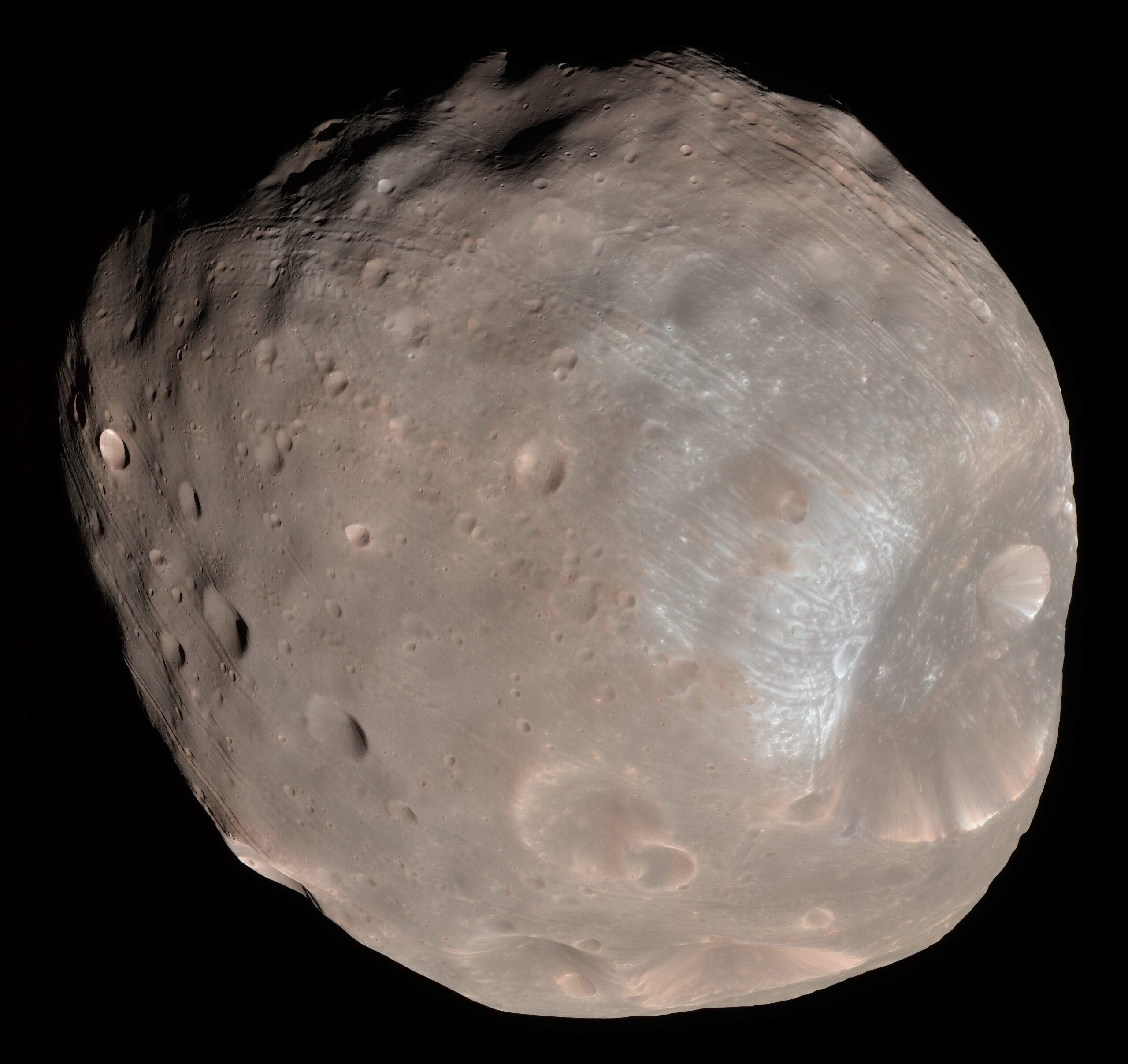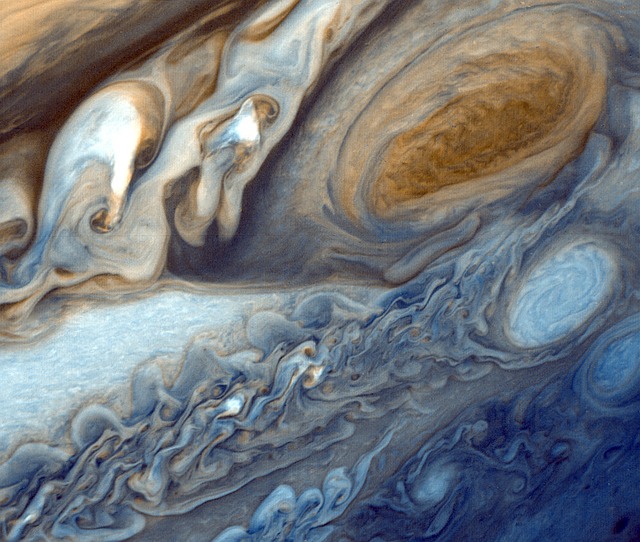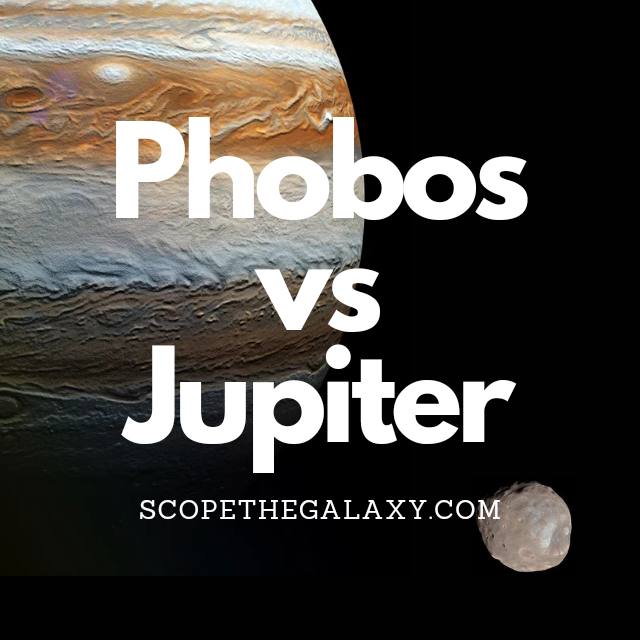*This post may contain affiliate links. This means we may make a commission if you purchase an item using one of our links*
The main differences between Phobos and Jupiter are that Phobos is a natural satellite and Jupiter is a gas giant planet, Phobos is very small with a diameter of 22.53km compared to Jupiter’s 139,820km, Jupiter has 79 objects orbiting it while Phobos has 0 and Jupiter has the strongest magnetosphere in our solar system while Phobos has none.
For a more detailed look at both entities along with their similarities and differences, continue reading as it will be covered in more detail throughout the remainder of this article.
What Is The Moon Phobos?
Table of Contents

Phobos is the larger and innermost of the Martian moons, named after the Greek God of fear and panic. This rocky satellite measures approximately 27 x 22 x 18 kilometers and possesses an irregular shape.
Flying only 270 km above Mars’s surface, Phobos orbits the Martian surface so closely that it spins around the planet three times a day (each orbit takes 7 hours and 39 minutes). And this proximity means that the moon cannot always be seen from Mars’ surface (it all depends on where you’re standing).
In general, Phobos rises in the west, passes through the sky in around 4 hours, and sets in the east. And this process occurs twice during one Martian day.
Phobos travels 1.8 m closer to Mars every 100 years, which means this doomed moon will one day crash into its planet or break up into rings. Still, this won’t happen for another 50 million years or so.
The moon is covered in streak patterns from impact craters, the most significant of which is the crater Stickney, with a diameter of 9.7 km. Phobos has weathered thousands of meteorite impacts, one of which almost shattered it to pieces.
It was first discovered by the American astronomer Asaph Hall on 17th August 1877. But, it can be difficult for astronomers to see as it is one of the least reflective bodies in the solar system with an albedo of 0.071.
Despite its small stature, Phobos experiences wildly varying temperatures on its dark side compared to the light side. Measurements on the light side of the moon suggest that temperatures can rise to -4 degrees Celsius, a sort of brisk winter’s day that would be cold but tolerable.
In contrast, temperatures on the dark side can drop to -112 degrees Celsius, even though the two areas are just a few kilometers apart. The probable cause is fine surface dust that cannot retain heat, allowing temperatures to drop rapidly.
The low density of Phobos suggests its composition is similar to carbonaceous chondrite meteorites, which could mean that Phobos is a captured asteroid.
What Is The Planet Jupiter?

Jupiter is the 5th farthest planet from the Sun and the largest planet within our local solar system. The planets most recognizable trait is the giant red spot visible on its atmosphere along with the brown horizontal bands flowing across its atmosphere.
As a result of its composition and size, Jupiter falls under the classification of a gas giant.
This is because its composition mostly consists of the elements hydrogen and helium. The split is roughly 71% hydrogen, 27% helium, with the remainder of the elements split throughout the left over 2%.
As the biggest planet in our solar system, Jupiter is 139,820 km or 1,300 Earths in diameter, it has a mass of around 0.001 solar masses, the temperature when inside the clouds are roughly -145 degrees Celsius whilst the core is far hotter, equating in the region of 24,000 degrees Celsius.
Due to its extreme circumstances, gaseous composition and distance from the Sun, the planet is not theoretically capable to support life, from its subzero temperature to the extremely fast 640 km/h winds, and its gravity which may be unsustainable for our bones, roughly 2.4 times greater than Earth’s.
Although the conditions on Jupiter aren’t suitable for us, some of its 79 moons like Europa for example could support life.
This brown giant has a relatively fast rotation around its axis where 1 rotation typically takes 10 hours to make whilst its orbit around the Sun is far longer taking in the region of 12 years for 1 full cycle.
Another feature of Jupiter that is renowned by astronomers is the strength of its magnetic field. In comparison to the other planets in our solar system it is even stronger than our Sun, where it’s over magnetosphere is roughly 20,000 times the strength of Earth.
What this means is that Jupiter’s magnetosphere is able to avert solar winds that are 3 million kilometers away from it.
Similarities Between Phobos And Jupiter
There are a few similarities that Jupiter and Phobos share, which in this case includes the following:
- Both are part of the same solar system.
- Neither have tectonic plates.
- Both orbit another larger object.
Differences Between Phobos And Jupiter
As for the differences between the two, they include the below.
- Phobos orbits Mars whilst Jupiter only orbits the Sun.
- Jupiter is a spherical shape while Phobos is not.
- Jupiter has 4 rings surrounding it while Phobos has 0.
- Jupiter is a gas giant planet whilst Phobos is a terrestrial based natural satellite.
- Jupiter has a diameter of 139,820km whilst Phobos has a diameter of 22.53km.
- Phobos has no atmosphere whilst Jupiter is gas based and therefore, is composed of hydrogen and helium.
- A day on Phobos takes 7 hours 39 minutes whilst a Jupiter day is 10 hours.
- It takes Phobos 7 hours 39 minutes to orbit Mars and around the Sun in 687 days whilst Jupiter orbits the Sun in 12 years.
- Jupiter has an axial tilt of 3.13 degrees whilst Phobos’ axial tilt is closer to 0.
- Phobos’ temperature ranges between -4 to -112 degrees Celsius whilst Jupiter has an average temperature of -145 degrees Celsius.
- Jupiter has 79 moons while Phobos has no moons orbiting it.
- Jupiter’s density is 1.33 g/cm³ whilst Phobo’s density is 1.88 g/cm³.
- Jupiter’s mass is 1.898 × 10^27 kg whilst Phobos’ mass is 10.6 × 10^15 kg.
- Phobos’ gravitational strength is 0.0057 m/s² whilst Jupiter’s is 24.79 m/s².
- Phobos is tidally locked to Mars whilst Jupiter is not tidally locked to anything.
- Phobos only orbits Mars 6,000km away and is getting closer to the planet by 1.8 meters every 100 years.
- Jupiter has the strongest magnetosphere in our solar system whilst Phobos has no magnetic field.
Summary
Jupiter and Phobos share very few similarities between themselves, such as the fact both are part of the same solar system and neither have tectonic activity on their surfaces but, they are definetly more different than they are similar.
Whether it be in regards to mass, size, physical composition, orbital period, density, magnetic field and more, which is why Jupiter is very distinct in its functions, especially when compared to the extremely small natural satellite that is Phobos.

